Physiology of Soccer Game : Literature Review
(1) Sekolah Tinggi Ilmu Kesehatan Surabaya
Abstract
Abstract
Soccer is the most popular sport in the world, with around 270 million people participated in this sport (FIFA, 2015). Soccer attracted attention either sport scientist or government all over the world to promoted the benefit of physical activity and also maintained people’s health, including the minorities. (Hammami et al, 2016; Milanovic et al., 2015; Parnell et al., 2016). Besides, this sport can be used to promote the health public in order to prevent chronic diseases cause lack of physical activity (Krustrup et al., 2010).
Physiological need of competitive soccer in highest level must have good physical condition in order to give maximal effort in a soccer match (run, hold the ball, passing and shooting). The fitness level optimization is a important aspect in the preparation of a team before joining the competition. There’s already many research done, showed the data that a men’s soccer professional player can reached 9-14 km of total distance covered in a soccer match. And in the Women’s elite soccer game, a player can reached about 8-12 km of total distance covered. (Bloomfeld, et al 2008).
But soccer is not always only about physical matter but also mental attributes needed. Research showed that mental fatigue during a soccer game may influenced the technical and physical aspect, made a player can’t showed their true ability.
This Review article made to show the physiological aspect of the game in soccer, resumed from scientific articles especially from Europe/USA where soccer was more advanced there. And the writer try to compare to the condition in Indonesia where soccer was still under developed there, the data showed that Indonesia was still in the bottom rank of FIFA. The writer hoped that this article can be used to developed sport science and sport medicine in his beloved country.
Â
Keywords : soccer , physiology, physical, energy , mental, sport science.
Keywords
Full Text:
PDFReferences
Daftar Pustaka
Alghannam, A.F. (2013) Physiology of soccer: The role of nutrition in performance. Novel Physiotherapists, 1-5.
Ascensao A, Leite M, Rebelo AN, Magalhäes S, Magalhäes J. Effects of cold water immersion on the recovery of physical performance and muscle damage following a one-off soccer match. J Sports Sci, 2011; 29: 217-225.
Bangsbo J. The physiology of soccer: with special reference to with soccer sportswear. intense intermittent exercise. Acta Physiol Scand 1994; 15 Suppl. 619: 1-156.
Bangsbo, J., Mohr, M. and Krustrup, P. (2006) Physical and metabolic demands of training and match-play in the elite football player. Journal of Sports Sciences, 24, 665-674.
Bangsbo, J. (2014) Physiological demands of football. Football Task Force, 27(125), 1-6.
Barnes, C., Archer, D.T., Hogg, B., Bush, M., & Bradley, P.S. (2014). The evolution of physical and technical performance parameters in the English Premier League. International Journal of Sports Medicine, 35(13), 1095-1100. doi: 10.1055/s-0034-1375695.
Behi, A., Fahey, T. D., Afsharnezhad, T., & Amani, A. R. (2017). Effect of High Intensity Interval Training with Blood Restriction on Anaerobic Performance. International Journal of Applied Exercise Physiology, 6(2), 45-52.
Bloomfield, J., Polman, R.C.J. and O’Donoghue, P.G. (2008) Reliability of the Bloomfield Movement Classification. International Journal of Performance Analysis of Sport-e 7(1), 20-27.
Boksem MA, Meijman TF, Lorist MM. Effects of mental fatigue on attention: an ERP study. Brain Res Cogn Brain Res. 2005;25(1): 107–16.
Burke, L., Loucks, A. and Broad, N. (2006) Energy and carbohydrate for training and recovery. Journal of Sports Science, 24, 675-685.
Clemente, F. M., Couceiro, M. S., Martins, L., Manuel, F., Ivanova, M. O., & Mendes, R. (2013). Activity profiles of soccer players during the 2010 world cup. Journal of Human Kinetics, 38, 201-211.
Coelho, D.B., Coelho, L.G., Mortimer, L.A., Condessa, L.A., Ferreira-Junior, J.B., Borba, D.A., Oliveira, B.M., Bouzas-Marins, J.C., Soares, D.D. and Silami-Garcia, E. (2010) Energy expenditure estimation during official soccer matches. Brazilian Journal of Biomotricity, 4(4), 246-25.
Di Salvo, V. and Pigozzi, F. (1998). Physical training of football players based on their positional roles in the team. Journal of Sports Medicine and Physical Fitness 38, 294-297.
Di Salvo, V., Baron, R., Tschan, H., Calderone, F.J., Bachl, N. and Pigozzi, F. (2007) Performance characteristics according to playing position in elite soccer. International Journal of Sports Medicine, 3(3), 222-227.
Draganidis D, Chatzinikolaou A, Avloniti A, Barbero-Alvarez JC, Mohr M, Malliou P, Gourgoulis V, Deli CK, Douroudos, II, Margonis K, Gioftsidou A, Flouris AD, Jamurtas AZ, Koutedakis Y, Fatouros IG. Recovery kinetics of knee flexor and extensor strength after a football match. PLoS One, 2015; 10: e0128072.
Ebine, N., Rafamantanantsoa, H.H., Nayuki, Y., Yamanka, K., Tashima, K., Ono, T., Saitoh, S. and Jones, P.J. (2002) Measurement of total energy expenditure by the doubly labelled water method in professional soccer players. Journal of Sports Sciences, 20(5), 391-397.
Ekblom B. Applied physiology of soccer. Sports Med 1986 Jan-Feb; 3 (1): 50-60
Eniseler, N. (2005) Heart rate and blood lactate concentrations as predictors of physiological load on elite soccer players during various training activities. Journal of Strength Conditioning and Research, 19(4), 799-804.
Fatouros IG, Jamurtas AZ. Insights into the molecular etiology of exercise-induced inflammation:
opportunities for optimizing performance. J Inflamm, 2016; 9: 175.
Faude, O., Koch, T., & Meyer, T. (2012). Straight sprinting is the most frequent action in goal situations in professional soccer. Journal of Sports Sciences, 30(7), 625-631. doi: 10.1080/02640414.2012.665940.
FIFA (2015) “Big Count.†FIFA. http://www.fifa.com/worldfootball/bigcount/allplayers.html.
Fransson D, Krustrup P, Mohr M. Running intensity fluctuations cause temporary performance decrements in top-class football Sci Med Footb, 2017; 1: 10-17.
Hammami, A., Chamari, K., Slimani, M., Shephard, R.J., Yousfi, N., Tabka, Z. and Bouhlel, E. (2016) Effects of recreational soccer on physical fitness and health indices in sedentary healthy and unhealthy subjects. Biology of Sport 33, 127-137.
Harris, J.A. and Benedict, F.G. (1919) A biometric study of human basal metabolism. Proc Natl Acad Sci USA, 4(2), 370-373.
Haugen, T., Tønnessen, E., & Seiler, S. (2012). Speed and countermovement jump characteristics of elite female soccer players 1995-2010. International Journal of Sports Physiology and Performance, 7(4), 340-349.
Ispirlidis I, Fatouros IG, Jamurtas AZ, Nikolaidis MG, Michailidis I, Douroudos I, Margonis K, Chatzinikolaou A, Kalistratos E, Katrabasas I, Alexiou V, Taxildaris K. Time-course of changes in inflammatory and performance responses following a soccer game. Clin J Sport Med, 2008; 18: 423-431.
Haugen, T., Tønnessen, E., & Seiler, S. (2013). Anaerobic performance testing of professional soccer players 1995-2010. International Journal of Sports Physiology and Performance, 8(2), 148-156.
Kellis E., Katis A., Vrabas I.S. (2006) Effects of an intermittent exercise fatigue protocol on biomechanics of soccer kick performance. Scandinavian Journal of Medicine and Science in Sports 16, 334-344 [PubMed]
Kenney, W. L., Wilmore, J., & Costill, D. (2015). Physiology of Sport and Exercise 6th Edition: Champaign, IL: Human Kinetics.
Krustrup, P., Mohr, M., Steensberg, A., Bencke, J., Kjaer, M. & Bangsbo, J. (2006). Muscle and blood metabolites during a soccer game: implications for sprint performance. Medicine and Science in Sports and Exercise, 38, (6), 1165-74.
Krustrup, P., Dvorak, J., Junge, A. and Bangsbo, J. (2010) Executive summary: The health and fitness benefits of regular participa-tion in small-sided football games. Scandinavian Journal of Medicine and Science in Sports 20, 132-135.
Krustrup P, Ortenblad N, Nielsen J, Nybo L, Gunnarsson TP, Iaia FM, Madsen K, Stephens F, Greenhaff P, Bangsbo J. Maximal voluntary contraction force, SR function and glycogen resynthesis during the first 72 h after a high-level competitive soccer game. Eur J Appl Physiol, 2011; 111: 2987-2995
Park, S., Kim, J. K., Choi, H. M., Kim, H. G., Beekley, M. D., & Nho, H. (2010). Increase in maximal oxygen uptake following 2-week walk training with blood flow occlusion in athletes. European Journal of Applied Physiology, 109(4), 591-600. doi: 10.1007/s00421-010-1377-y
MacDougall JD, Wenger HA, Green HJ, 1983. Physiological Testing of the Elite Athlete, New York: Mouvement Publications.
Manore, M. and Thompson, J. (2006) Energy requirements of the athlete: Assessment and evidence of energy deficiency. In: Clinical Sports Nutrition. Roseville, CA, USA: McGraw Hill, 113-134.
Martin K, Thompson KG, Keegan R, Ball N, Rattray B. Mental fatigue does not affect maximal anaerobic exercise performance. Eur J Appl Physiol. 2015;115(4):715–25.
Milanović, Z., Pantelić, S., Čović, N., Sporiš, G. and Krustrup, P. (2015) Is Recreational Soccer Effective for Improving VO2 max? A Systematic Review and Meta-Analysis. Sports Medicine 45, 1339-1353.
Mohr, M., Krustrup, P. and Bangsbo, J. (2002) Match performance of high-standard soccer players with special reference to develop-ment of fatigue. Journal of Sports Sciences 21, 519-528.
Mohr, M., Nybo, L., Grantham, J. & Racinais, S. (2012). Physiological responses and physical
performance during football in the heat. PLoS One, 7, (6), e39202.
Mohr M, Draganidis D, Chatzinikolaou A, Barbero-Alvarez JC, Castagna C, Douroudos I, Avloniti A, Margeli A, Papassotiriou I, Flouris AD, Jamurtas AZ, Krustrup P, Fatouros IG. Muscle damage, inflammatory, immune and performance responses to three football games in 1 week in competitive male players. Eur J Appl Physiol, 2016; 116: 179-193
Ozaki, H., Sakamaki, M., Yasuda, T., Fujita, S., Ogasawara, R., Sugaya, M., . . . Abe, T. (2010). Increases in thigh muscle volume and strength by walk training with leg blood flow reduction in older participants. Journals of Gerontology Series A: Biomedical Sciences and Medical Sciences, 66(3), 257-263.
Parnell, D., Cope, E., Bailey, R., Krustrup, P. and Curran, K. (2016) Football and physical health: what do we know? Sport in Socie-ty 6, 1-21.
Reilly, T. and Thomas, V. (1976) A time motion analysis of work rate in different positional roles in professional match play. Journal of Human Movement Studies, 2, 87-99.
Reilly, T. and Thomas, V. (1979) Estimated daily energy expenditure of professional association footballers. Ergonomics, 22, 541-548.
Reilly, T. (1997) Energetics of high-intensity exercise (soccer) with particular reference to fatigue. Journal of Sports Sciences, 15, 257-263.
Reilly, T. (2003) Motion analysis and physiological demands. In: Science and Soccer. Eds: Williams, A.M. and Reilly, T. 2nd Edi-tion. London, E & FN Spon. 59-72.
Rico-Sanz, J. (1998) Body Composition and Nutritional Assessments in Soccer. International Journal of Sports Nutrition, 8, 113-123.
Shephard, R. and Towler, G. (1992) Nutrition knowledge, attitudes and fat consumption. Journal of the American Dietetic Association, 5, 387-397.
Shephard, R. (1999) Biology and medicine in soccer: an update. Journal of Sports Science, 17, 757-786.
Silva JR, Ascensão A, Marques F, Seabra A, Rebelo A, Magalhães J. Neuromuscular function, hormonal and redox status and muscle damage of professional soccer players after a high-level competitive match. Eur J Appl Physiol, 2013; 113: 2193-2201.
Stolen, T., Chamari, K., Castagna, C. and Wisloff, U. (2005) Physiology of soccer: an update. Sports Medicine, 35, 501-536.
Taylor, L. & Rollo, I. 2014. Impact Of Altitude And Heat On Football Performance. Gatorade
Sport Science Institute (GSSI) - Sports Science Exchange (SSE) [Online], 27.Available:
http://www.gssiweb.org/Article/sse-131-impact-of-altitude-and-heat-on-footballperformance.
Varley M, Aughey R. Acceleration profiles in elite Australian soccer. Int J Sports Med, 2012; 34: 282-287.
West, J. B., Schoene, R. B. & Milledge, J. S. 2007. High Altitude Medicine and Physiology, London, Hodder Arnold.
Williams, J.H (2012) The Science behind Soccer Nutrition. 2nd ed.
Withers RT, Maricic Z, Wasilewski S, et al. Match analysis of Australian professional soccer players. J Hum Mov Stud 1982; 8: 159-76
Refbacks
- There are currently no refbacks.
Published by:
Department of Sport Science, Universitas Negeri Semarang
Gd. F1 Lt. 1 FIK-UNNES, Jalan Raya Sekaran Gunungpati Semarang Indonesia 50229, Telp/Fax: (024) 8508007
This work is licensed under a Creative Commons Attribution 4.0 International License.




